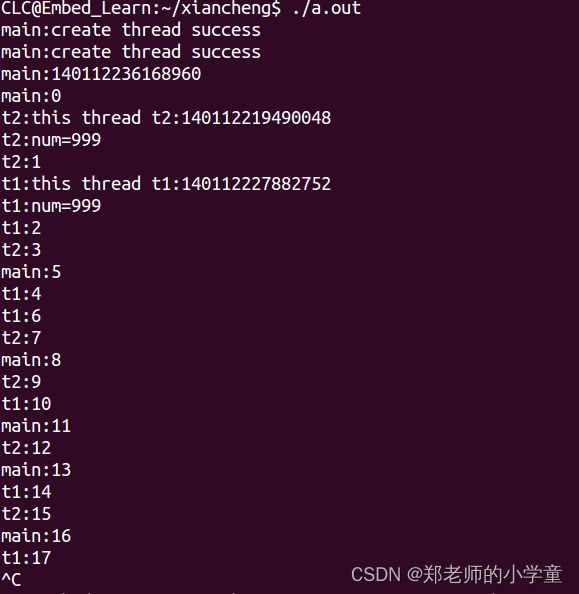Linux线程——常用API
线程创建
函数原型及头文件
#include
int pthread_create(pthread_t *restrict tidp, const pthread_attr_t *restrict attr, void *(*start_rtn)(void *), void *restrict arg);
参数解读
| tidp | 当pthread_create成功返回时,由tidp指向的内存单元被设置为新创建线程的线程ID。(指针,输入方式是地址) |
| attr | 一般设为NULL。attr参数用于定制各种不同的线程属性,暂可以把它设置为NULL,以创建默认属性的线程。 |
(*start_rtn)(void *) |
新创建的线程的入口地址。新创建的线程从start_rtn函数的地址开始运行,该函数只有一个无类型指针参数arg。 |
| arg | 向start_rtn函数传递的参数。如果需要向start_rtn函数传递的参数不止一个,那么需要把这些参数放到一个结构中,然后把这个结构的地址作为arg参数传入。(指针,输入方式是地址,同时要注意是void *型) |
返回值
若成功返回0,否则返回错误编号。
线程退出
单个线程可以通过以下三种方式退出,在不终止整个进程的情况下停止它的控制流:
1)线程只是从启动例程中返回,返回值是线程的退出码。
2)线程可以被同一进程中的其他线程取消。
3)线程调用pthread_exit。
函数原型及头文件
#include
int pthread_exit(void *rval_ptr); 参数解读
rval_ptr:一个无类型指针,与传给启动例程的单个参数类似。进程中的其他线程可以通过调用pthread_join函数访问到这个指针。
线程等待
调用这个函数的线程将一直阻塞,直到指定的线程调用pthread_exit、从启动例程中返回或者被取消。如果例程只是从它的启动例程返回i,rval_ptr将包含返回码。如果线程被取消,由rval_ptr指定的内存单元就置为PTHREAD_CANCELED。
可以通过调用pthread_join自动把线程置于分离状态,这样资源就可以恢复。如果线程已经处于分离状态,pthread_join调用就会失败,返回EINVAL。
函数原型及头文件
#include
int pthread_join(pthread_t thread, void **rval_ptr); 参数解读
| thread | 线程名 |
| **rval_ptr | 线程的返回值。如果对线程的返回值不感兴趣,可以把rval_ptr置为NULL。在这种情况下,调用pthread_join函数将等待指定的线程终止,但并不获得线程的终止状态。 |
返回值
若成功返回0,否则返回错误编号。
线程脱离
函数原型及头文件
#include
int pthread_detach(pthread_t thread); 参数解读
一个线程或者是可汇合(joinable,默认值),或者是脱离的(detached)。当一个可汇合的线程终止时,它的线程ID和退出状态将留存到另一个线程对它调用pthread_join。脱离的线程却像守护进程,当它们终止时,所有相关的资源都被释放,我们不能等待它们终止。如果一个线程需要知道另一线程什么时候终止,那就最好保持第二个线程的可汇合状态。
pthread_detach函数把指定的线程转变为脱离状态。
返回值
若成功返回0,否则返回错误编号。
其他
本函数通常由想让自己脱离的线程使用,就如以下语句:
pthread_detach(pthread_self());线程ID获取
函数原型及头文件
#include
pthread_t pthread_self(void); 返回值
调用线程的ID。
线程比较
对于线程ID比较,为了可移植操作,我们不能简单地把线程ID当作整数来处理,因为不同系统对线程ID的定义可能不一样。
函数原型及头文件
#include
int pthread_equal(pthread_t tid1, pthread_t tid2); 参数解读
| tid1 | 线程1的名字 |
| tid2 | 线程1的名字 |
返回值
若相等则返回非0值,否则返回0。
代码示例
线程返回数字打印
#include
#include
void *func1(void *arg)
{
static int ret = 1;//static保留数据 不然函数调用后空间无效
printf("t1:this thread t1:%ld \n",(unsigned long)pthread_self());//self是void型 需对其进行强转
printf("t1:num=%d\n",*((int *)arg));//传参过来的是主函数的num num取地址传过来需先将void型转成int型 再通过指针指向其地址得到数据
pthread_exit((void *)&ret);//线程的退出 可附带线程的返回值 可通过pthread_join调用得到该数据
}
int main()
{
int ret;
int num =999;
int *pret;
pthread_t t1;
ret = pthread_create(&t1,NULL,func1,(void *)&num);//第四个参数是void *型 而num是int型 需要对其进行强转 同时其输出为指针 则需要加上地址符号
if(ret == 0)//判断线程是否创建成功
{
printf("main:create thread success\n");
}
printf("main:%ld\n",(unsigned long)pthread_self());
pthread_join(t1,(void **)&pret);//线程等待 等待上面函数退出之后再执行下面语句
printf("main:ti quit %d\n",*pret);//打印出线程的返回值
return 0;
}
线程返回字符串打印
#include
#include
void *func1(void *arg)
{
static char *p = "hello word";
printf("t1:this thread t1:%ld \n",(unsigned long)pthread_self());
printf("t1:num=%d\n",*((int *)arg));
pthread_exit((void *)p);
}
int main()
{
int ret;
int num =999;
char *pret;
pthread_t t1;
ret = pthread_create(&t1,NULL,func1,(void *)&num);
if(ret == 0)
{
printf("main:create thread success\n");
}
printf("main:%ld\n",(unsigned long)pthread_self());
pthread_join(t1,(void **)&pret);
printf("main:ti quit %s\n",pret);//字符串的名字为地址 不需要加地址符
return 0;
}
线程共享内存空间
#include
#include
int data = 0;
void *func1(void *arg)
{
printf("t1:this thread t1:%ld \n",(unsigned long)pthread_self());
printf("t1:num=%d\n",*((int *)arg));
while(1)
{
printf("t1:%d\n",data++);
sleep(1);
}
}
void *func2(void *arg)
{
printf("t2:this thread t2:%ld \n",(unsigned long)pthread_self());
printf("t2:num=%d\n",*((int *)arg));
while(1)
{
printf("t2:%d\n",data++);
sleep(1);
}
}
int main()
{
int ret;
int num =999;
pthread_t t1;
pthread_t t2;
ret = pthread_create(&t1,NULL,func1,(void *)&num);
if(ret == 0)
{
printf("main:create t1 success\n");
}
ret = pthread_create(&t2,NULL,func2,(void *)&num);
if(ret == 0)
{
printf("main:create t2 success\n");
}
printf("main:%ld\n",(unsigned long)pthread_self());
while(1)
{
printf("main:%d\n",data++);
sleep(1);
}
pthread_join(t1,NULL);
pthread_join(t2,NULL);
return 0;
}


